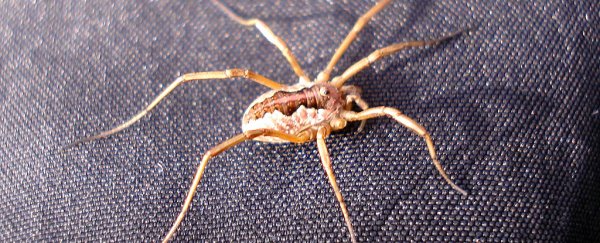Neuroscientists have figured out how to remove specific fears from patients' brains using a combination of artificial intelligence (AI) and brain scanning technology, and the technique could change the lives of people with crippling phobias – such as of opiliones, like the one pictured above.
The process, called Decoded Neurofeedback, doesn't require any conscious effort on the part of the subject to overcome their fears, but relies on identifying brain patterns related to a certain fear, which are then 'overwritten' using a reward system.
Even better, it looks like the fears are gone for good after treatment, and the researchers say the technique could eventually be used to help treat conditions such as post-traumatic stress disorder (PTSD).
"When we induced a mild fear memory in the brain, we were able to develop a fast and accurate method of reading it by using AI algorithms," explains researcher Ben Seymour from the University of Cambridge in the UK.
"The challenge then was to find a way to reduce or remove the fear memory, without ever consciously evoking it."
Working with 17 volunteers, the scientists first created a 'fear memory' in the participants by associating a certain image with a brief electric shock.
 One of the brain scans mapped with AI. Credit: Ai Koizumi
One of the brain scans mapped with AI. Credit: Ai Koizumi
Over the next three days, the volunteers were given a small amount of money as a reward whenever the same brain pattern was spotted. Those taking part were told that the reward depended on their brain activity, but it was never explained how.
The aim was to gradually associate the AI-identified pattern with a reward rather than something scary, even when the image wasn't consciously brought to mind.
"In effect, the features of the memory that were previously tuned to predict the painful shock, were now being reprogrammed to predict something positive instead," says lead researcher Ai Koizumi from the Advanced Telecommunications Research Institute International in Kyoto, Japan.
The real test was how the participants would react when shown the original frightening set of images, but when this happened the researchers spotted no signs of fear or enhanced activity in the amygdala – the brain's 'fear centre'.
"This meant that we'd been able to reduce the fear memory without the volunteers ever consciously experiencing the fear memory in the process," says Koizumi.
That's in stark contrast to the traditional exposure therapy treatment, which involves exposing people with anxiety disorders to the cause of their anxiety in a safe setting.
It often works – it's the old idea of 'confronting your fears' to overcome them – but the team behind the new study thinks we can improve on it.
Although the sample size in this study was very small, the researchers think their new technique could be developed to create a less stressful way of helping people overcome their fears – which is good news for the 4 to 5 percent of the population with phobias.
"To apply this to patients, we need to build a library of the brain information codes for the various things that people might have a pathological fear of, say, spiders," says Seymour.
"Then, in principle, patients could have regular sessions of Decoded Neurofeedback to gradually remove the fear response these memories trigger."
The findings have been published in Nature Human Behaviour.
